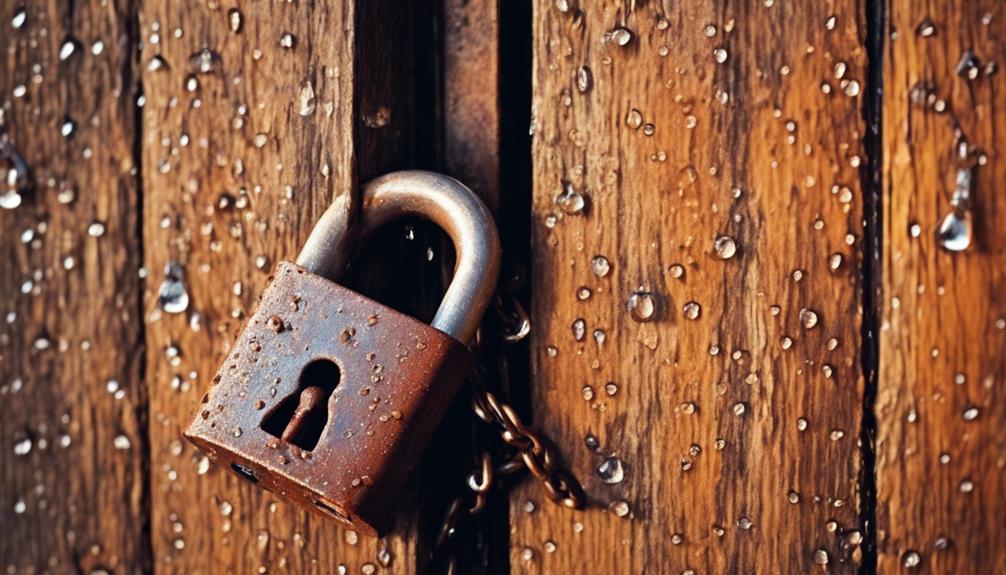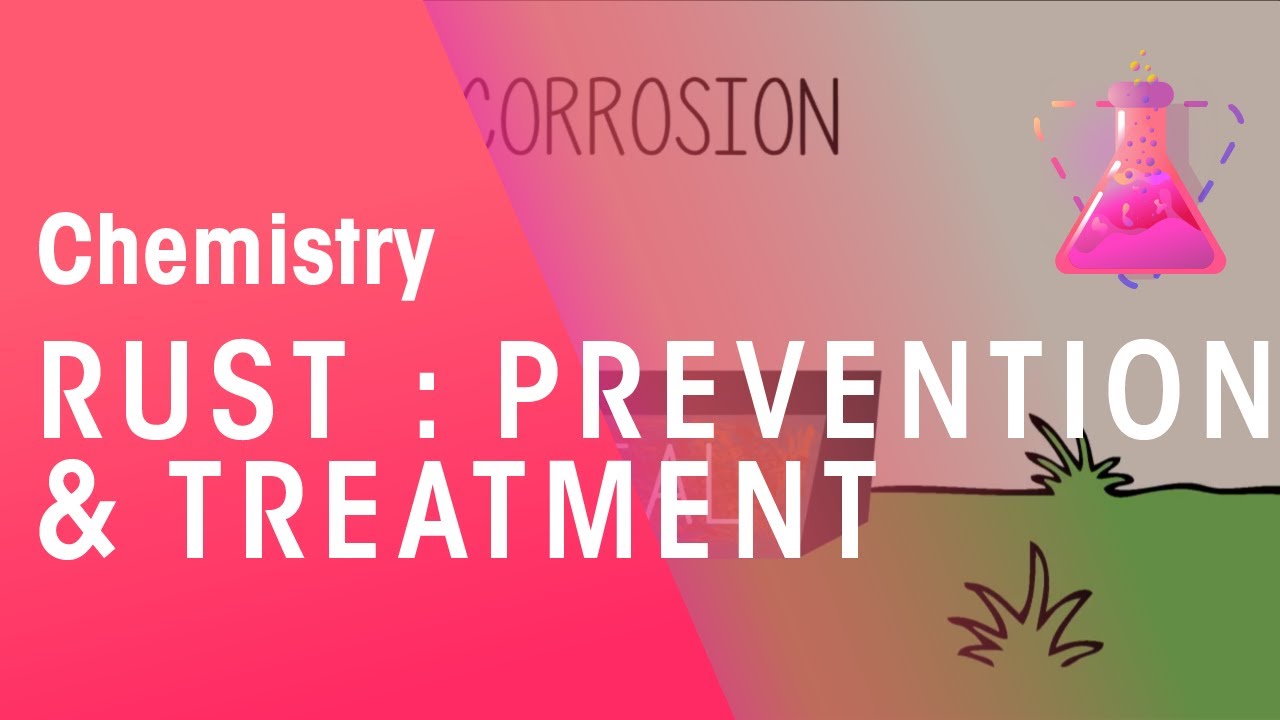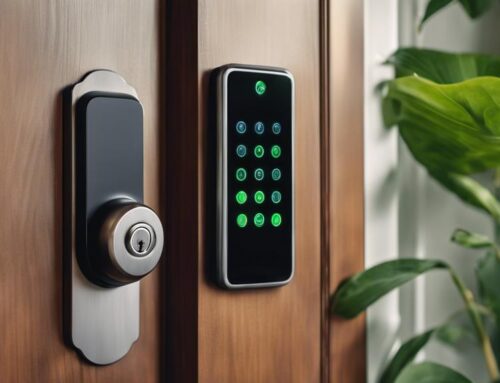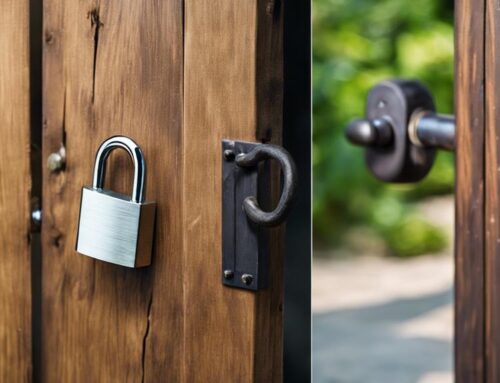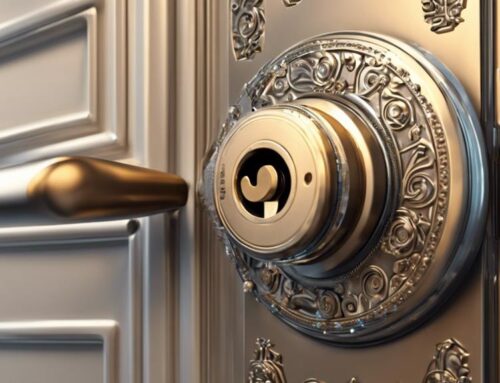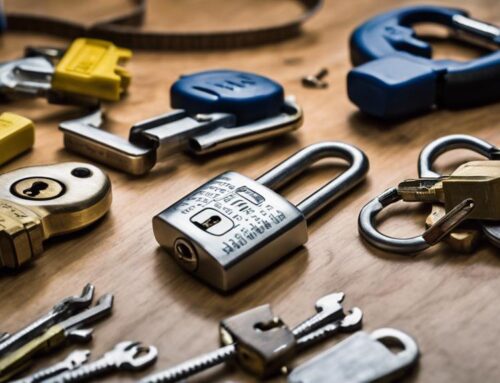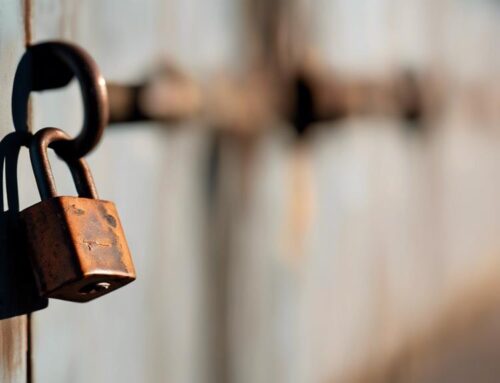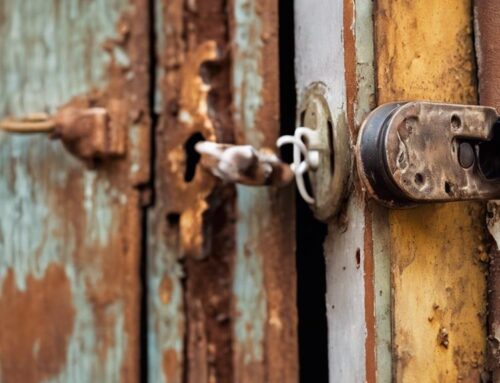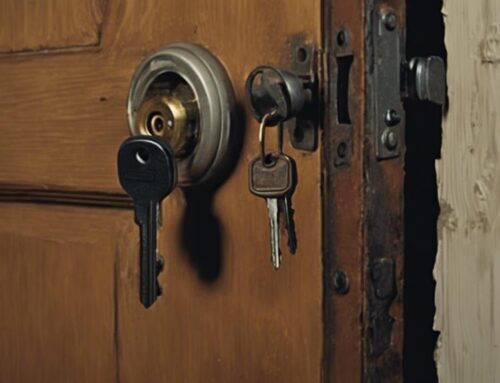Yes, rust on your lock is a serious problem that can affect both functionality and security. When rust forms, it can make it challenging to open or close the lock, leading to potential issues in emergencies. More importantly, rust weakens the lock's mechanism, making it easier to pick or force open, which increases the risk of theft. Regular exposure to moisture especially contributes to rust buildup. If you notice signs like difficulty turning the key or visible discoloration, it's vital to address the rust promptly. Want to know how to effectively manage and prevent rust?
Key Takeaways
- Rust on locks can significantly degrade performance, leading to difficulty in opening or closing mechanisms.
- Corroded locks are more vulnerable to theft, as rust weakens their integrity and functionality.
- Early signs of rust indicate potential internal damage, which may necessitate immediate maintenance or replacement.
- Regular inspections and maintenance can prevent rust buildup and prolong the lifespan of locks.
- Investing in high-quality, weather-resistant locks reduces the risk of rust and enhances security.
Understanding Rust Formation
Rust typically forms when metal encounters moisture and oxygen, creating a chemical reaction known as oxidation. This process can be exacerbated by poor quality locks or inadequate protective coatings, leading to quicker deterioration.
If you've noticed rust on your lock, it's important to understand how this process occurs, especially since it can lead to significant lock rust problems over time. For effective prevention, mastering sticking locks is crucial to maintaining functionality.
Lock corrosion happens when metal components break down, often due to prolonged exposure to dampness or harsh weather conditions. This deterioration not only affects the aesthetic appeal of your lock but can also compromise its integrity.
Rust can build up in the crevices, making it difficult to operate the lock smoothly.
To combat lock rust problems, regular lock maintenance is crucial. You can start by inspecting your locks frequently for any signs of corrosion.
If you spot rust, address it immediately by using a rust remover or a gentle abrasive. After cleaning, apply a lubricant designed for locks to help protect against future moisture exposure.
By taking these proactive steps, you can guarantee your locks remain functional and secure, ultimately serving your needs better.
Impact of Rust on Functionality
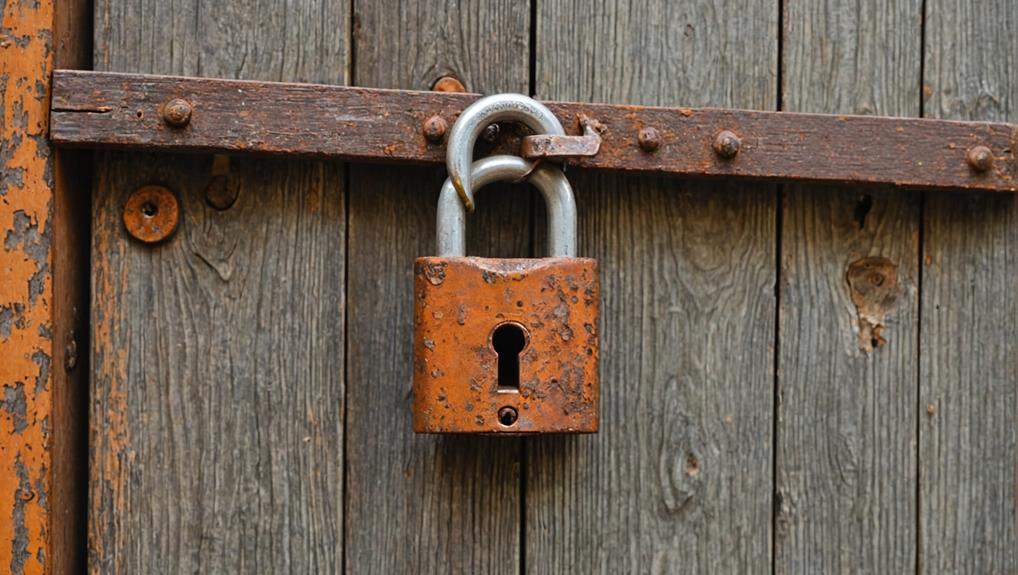
Rust can considerably reduce your lock's performance, making it harder to open or close.
This deterioration not only frustrates you but also increases security risks, leaving your belongings vulnerable.
In fact, the risks associated with loose locks can be exacerbated by rust, as it may prevent the lock from functioning properly.
Understanding these impacts can help you take action before it's too late.
Reduced Lock Performance
When moisture seeps into the inner workings of a lock, it can lead to a significant decline in its performance. You may find that turning the key becomes increasingly difficult, or the lock may grind and stick. This rust on door locks results in lock corrosion damage, which compromises lock durability. Understanding these effects can help you serve others better by guaranteeing their locks function smoothly.
Here's a quick overview of how rust affects lock performance:
| Effect | Description | Impact on Service |
|---|---|---|
| Difficulty Turning | Rust buildup can make keys hard to turn | Increased frustration for users |
| Sticking Mechanism | Rust can cause the lock to jam | Delays in accessing secured areas |
| Shortened Lifespan | Corrosion leads to premature failure | Higher replacement costs |
| Reduced Security | Compromised locks can be easily bypassed | Increased vulnerability |
Taking preventive measures against rust not only enhances the lock's longevity but also guarantees that you're providing a reliable service to those who depend on it. Regular maintenance can mitigate these issues and promote trust in your handling of security devices.
Increased Security Risks
As locks degrade due to rust, the security they provide can be severely compromised. When a lock becomes rusted, you're not just facing a mechanical issue; you're risking your safety and that of others around you.
Here are three key security risks associated with rusted locks:
- Weakened Mechanism: Rust can cause internal components to seize, making it easier for intruders to exploit vulnerabilities.
- Increased Wear: A rusted lock is more likely to fail completely, leaving your property unprotected and vulnerable to theft or vandalism.
- Difficulty in Access: Replacing rusted locks becomes a priority when they can't be opened easily, potentially locking you out when you need access the most.
To mitigate these risks, consider regular lock rust prevention measures, like keeping your locks clean and lubricated.
If you're already facing the consequences, don't hesitate to seek rusted lock replacement. Replacing rusted locks guarantees you maintain a secure environment for yourself and those you care about.
Security Risks of Rusted Locks
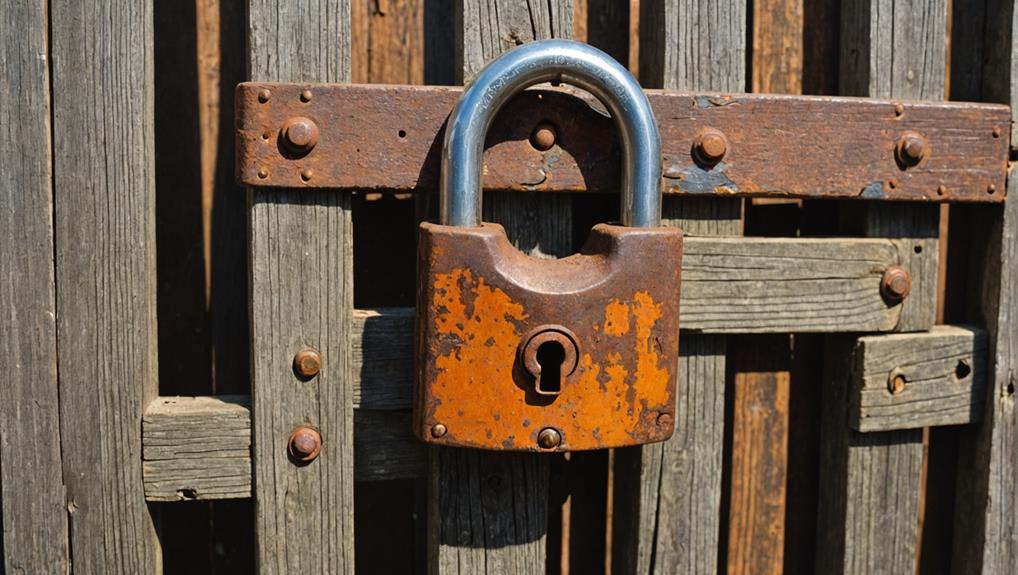
Have you ever pondered how a rusted lock can compromise your security? A rusty lock doesn't just look unsightly; it can be a major vulnerability for your home or business. When a lock begins to rust, it loses its effectiveness, making it easier for intruders to pick or force it open. This puts your belongings and loved ones at risk.
Additionally, when replacing locks, it's crucial to evaluate security upgrades to enhance your protection against potential threats.
Moreover, rust can create friction, making it difficult to turn the key. You might find yourself struggling to open your door during an emergency, which can lead to panic and further complications.
If you're committed to serving others, ensuring their safety should be a top priority, and a rusty lock compromises that mission.
Regular maintenance of your locks can prevent rust from taking hold, but you need to stay vigilant. If you notice any signs of rust, it's time to take action. Replace that rusty lock before it becomes a gateway for unwanted guests.
By addressing this issue promptly, you're not just protecting your own space; you're also contributing to a safer community for everyone around you.
Don't let a rusty lock jeopardize your security and peace of mind.
Signs Your Lock Is Rusted
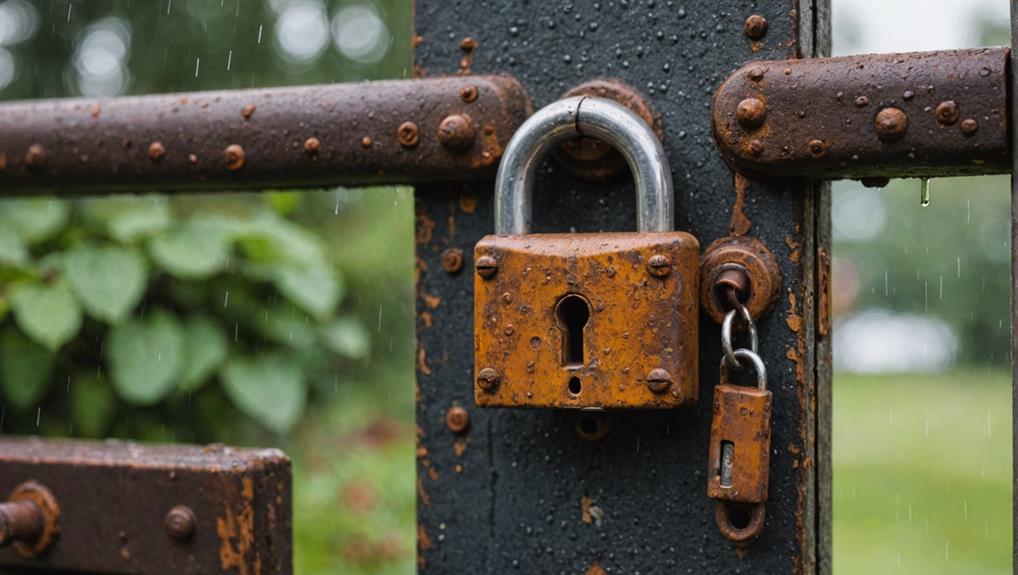
Your lock's performance can tell you a lot about its condition, and spotting signs of rust early can save you from bigger problems down the line.
Regular maintenance can help prevent these issues, as preventing mechanical failures is vital for keeping your locks in good working order.
If you're dedicated to serving others by ensuring their safety, keeping an eye on your locks is essential.
Here are three signs that your lock might be rusted:
- Difficulty Turning the Key: If your key feels stiff or it takes extra effort to turn, rust could be building up inside the lock. This can lead to further issues if not addressed promptly.
- Visible Rust or Discoloration: Check for any reddish-brown patches or flaking on the surface. If you see these signs, it's likely your lock is rusting and could fail when you need it most.
- Unusual Noises: If your lock makes grinding or squeaking sounds when you attempt to operate it, that could indicate rust or debris inside. Ignoring these noises could result in a lockout situation.
Types of Locks Prone to Rust
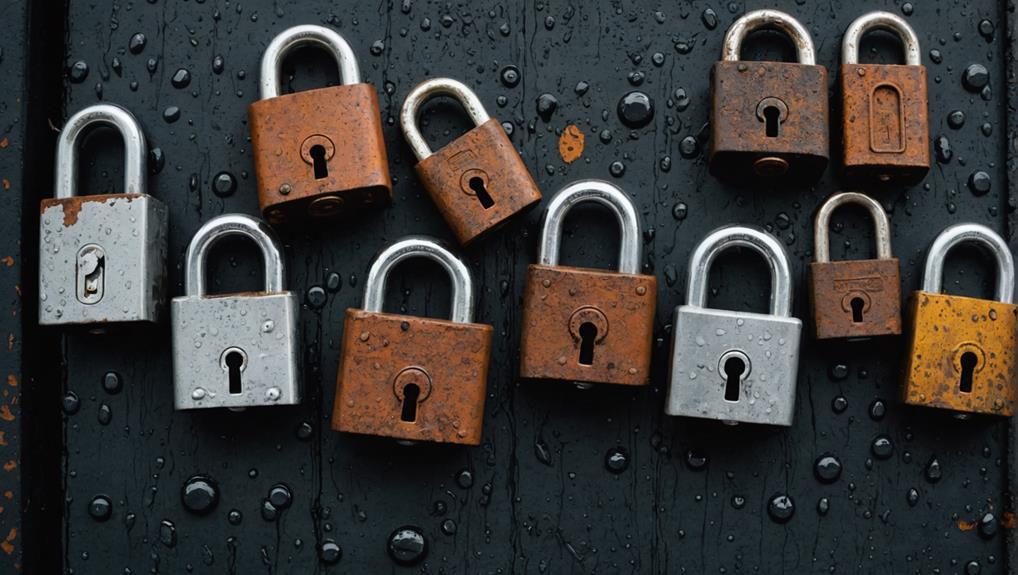
Certain types of locks are more vulnerable to rust, particularly those exposed to harsh weather conditions or moisture.
Investing in higher-quality locks can mitigate rust issues and provide long-term benefits, as investing in quality locks often yields better durability and resistance to environmental factors.
If you're considering which locks to install for your community or service spaces, you'll want to be mindful of the materials used.
For instance, standard steel locks, while durable, can quickly succumb to rust when left outdoors or in humid environments.
Bronze and brass locks may resist rust better, but they can still tarnish and corrode.
It's important to highlight that padlocks, especially those made of lesser-quality metals, often face rust challenges when used in outdoor settings.
Additionally, mortise locks installed in doors without adequate weather protection can also be at risk.
Even locks made from stainless steel can rust if not properly coated or maintained.
Preventing Rust on Locks
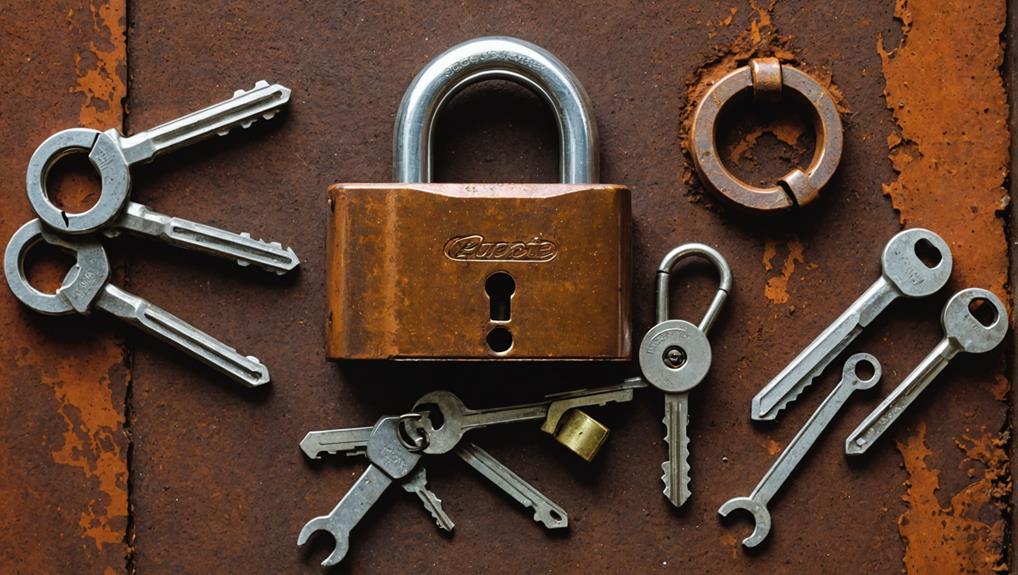
To prevent rust on locks, regular maintenance is key. Understanding the importance of protecting your locks can save you from costly repairs or replacements in the future, as lock re-keying costs can add up quickly.
By taking a few simple steps, you can guarantee that your locks remain in good condition and serve others well. Here are three effective strategies to keep rust at bay:
- Clean and Dry Regularly: After exposure to moisture, wipe down your locks with a clean, dry cloth. This simple action removes any water that can lead to rust formation.
- Use Lubricants: Apply a rust-inhibiting lubricant every few months. A silicone-based spray or graphite powder works wonders in creating a protective barrier against moisture.
- Inspect and Repair: Regularly check your locks for any signs of wear or damage. If you notice rust starting to form, address it immediately to prevent further deterioration.
Temporary Solutions for Rusted Locks
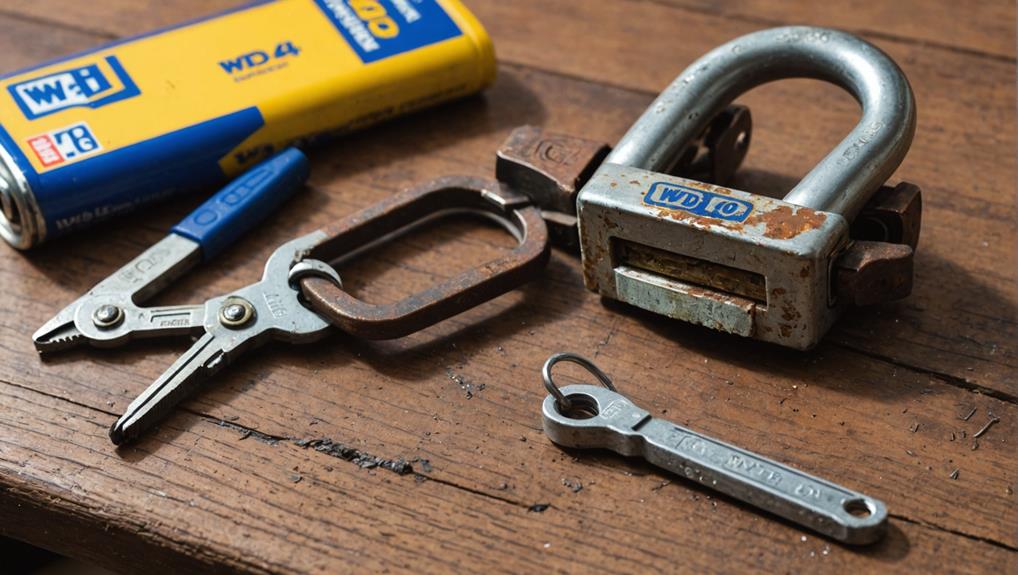
What should you do when you discover rust on your locks? First, don't panic. You can take some quick steps to address the issue.
Start by cleaning the rusted area with a wire brush or sandpaper. This helps remove loose rust particles and exposes the lock's surface. Make sure to wear gloves to protect your hands while you work. Regular maintenance, including understanding lock re-keying, can also help prevent rust issues by ensuring your locks are functioning properly.
Next, apply a penetrating oil or lubricant like WD-40 to the affected area. This can help loosen the rust and make it easier to operate the lock. Give it a few minutes to soak in before trying to turn the key or operate the lock.
If the lock still feels stiff, try turning the key gently back and forth to work the lubricant into the mechanism. Be patient; forcing it can lead to further damage.
Lastly, once the lock operates smoothly again, wipe away any excess lubricant and consider applying a rust inhibitor to prevent future issues.
When to Replace Your Lock
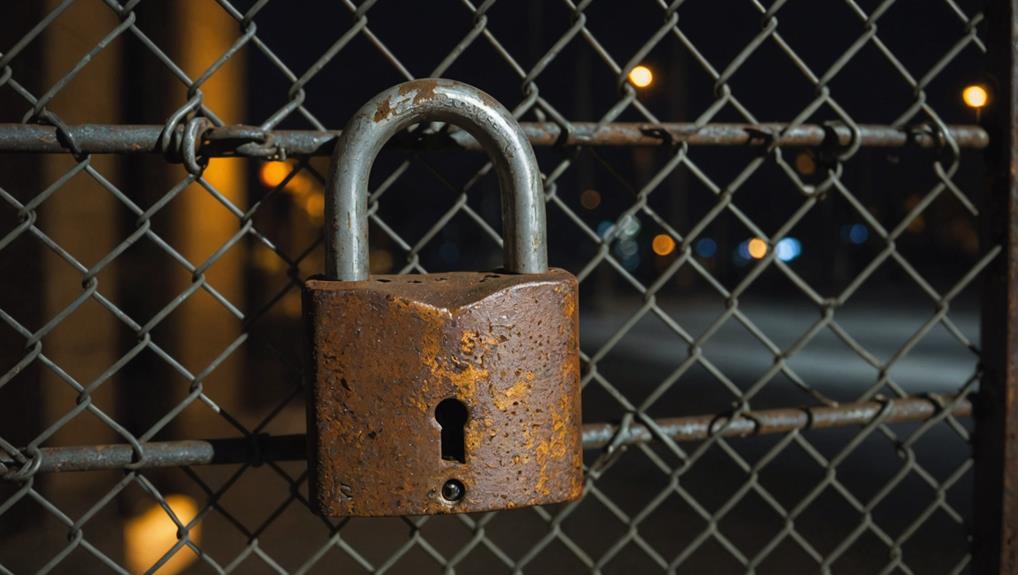
If you notice signs of wear on your lock, like difficulty turning the key or visible rust, it's time to contemplate a replacement.
common warning signs can help you identify when your lock may be at risk.
Rust can compromise the lock's integrity, making it easier for intruders to bypass.
Don't wait until it's too late—assess the impact rust has on your lock's performance.
Signs of Wear
Locks, like any other mechanical device, can show signs of wear over time that signal it's time for a replacement.
Recognizing these signs is essential for maintaining safety and security for yourself and those you care about. Here are three key indicators to watch for:
1. Difficulty Turning the Key: If you find yourself struggling to turn your key, it's a clear sign that the internal mechanisms are wearing out.
This can lead to frustration and may even leave you locked out.
2. Inconsistent Locking: A lock that doesn't engage or disengage smoothly can be a serious issue.
If you notice it often sticks or requires extra effort, consider replacing it.
3. Visible Damage: Inspect your lock regularly.
If you see cracks, chips, or rust forming, it's a strong indication that your lock's integrity is compromised, making it less secure.
Rust Impact Assessment
Rust can greatly impact a lock's functionality and security, making it vital to assess its condition regularly.
When you notice rust starting to form, it's important to evaluate the severity. A small amount of surface rust may be manageable with some cleaning and lubrication, but deeper rust can compromise the lock's integrity.
If you find the lock is difficult to turn or feels gritty, it's a clear sign that rust is affecting its performance. In such cases, don't hesitate to take action. If cleaning doesn't restore its smooth operation, consider replacing the lock.
Also, think about the potential risks. A rusty lock may not secure your property adequately, putting those you serve at risk. If your lock shows signs of extensive rust or is beyond repair, replacing it's a responsible choice.
Regular maintenance and inspections can help prevent rust from becoming a significant issue.
Choosing the Right Replacement Lock
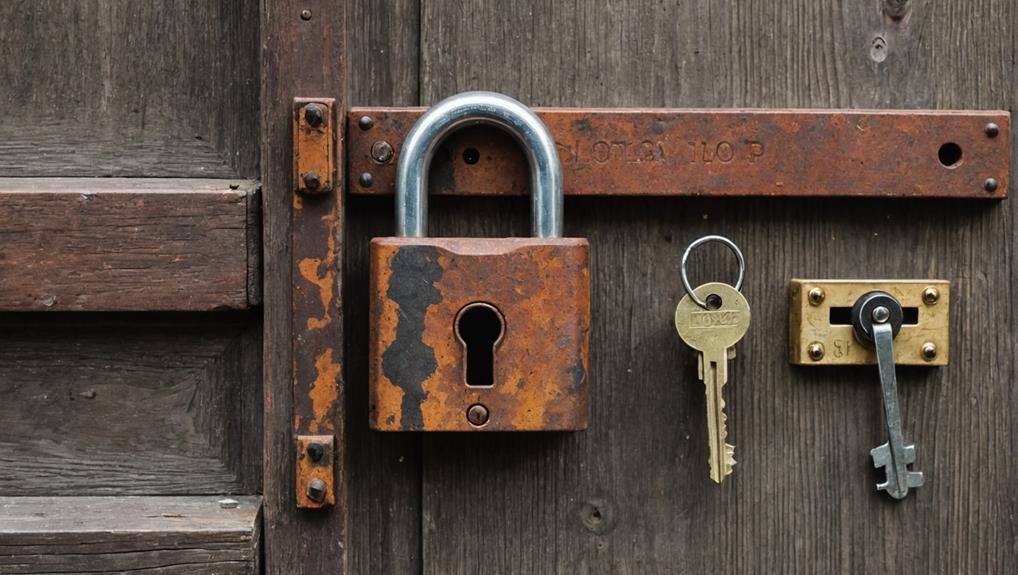
When it comes to choosing the right replacement lock, understanding your specific needs is essential. You want a lock that not only secures your belongings but also offers reliability and ease of use for those you serve.
Consider consulting a guide on choosing the perfect lock to guarantee you make an informed decision. Here are three key factors to take into account:
- Security Level: Assess the sensitivity of what you're protecting. Higher security locks, like deadbolts or electronic locks, provide more protection against unauthorized access.
- Ease of Use: Think about who'll be using the lock. If children or elderly individuals will access it, opt for user-friendly designs, like keypad locks, that eliminate the need for keys.
- Weather Resistance: If the lock will be exposed to the elements, choose materials that resist corrosion, such as stainless steel or brass, to ensure longevity and reliable performance.
Maintenance Tips for Longevity
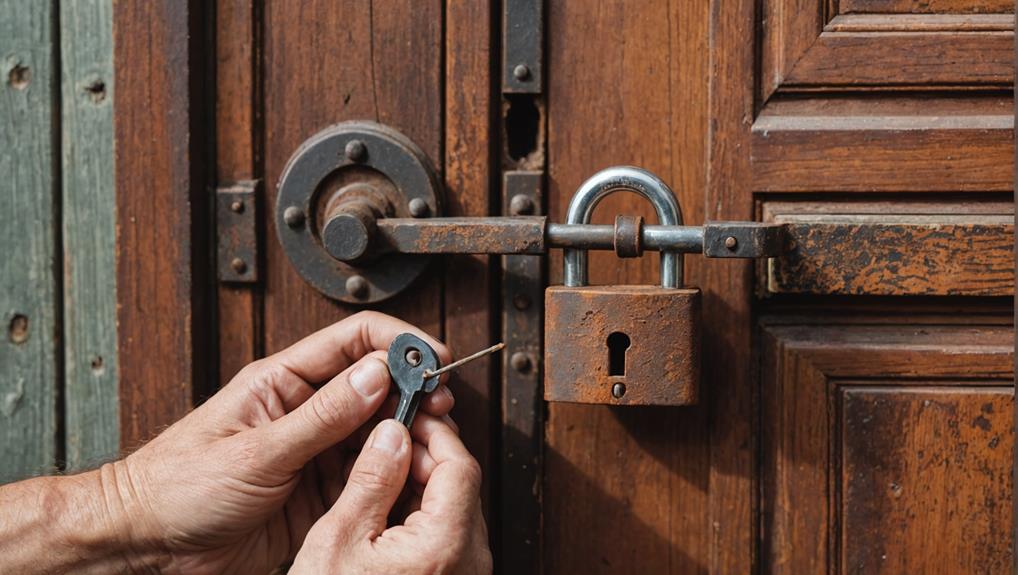
To keep your new lock functioning smoothly and to extend its lifespan, regular maintenance is key. Start by inspecting your lock frequently for signs of wear or rust. If you notice any corrosion, act quickly to clean it away using a soft cloth and a rust remover designed for metal.
Different types of locks have varying lifespans, so understanding when to replace them is vital for ideal security, especially if you notice significant wear the lifespan of different locks.
Lubrication is another important step. Use a silicone-based lubricant or graphite powder to keep the moving parts functioning properly. Avoid oil-based products, as they can attract dirt and debris, leading to more issues down the line.
Don't forget to check the screws and bolts holding the lock in place. Tighten any loose screws to guarantee a secure fit. Additionally, consider applying a protective coating to the lock's exterior to guard against moisture and rust.
If your lock is exposed to harsh weather conditions, think about covering it or using a weatherproof lock. Regularly wiping down your lock with a damp cloth can also help remove dust and grime.
Frequently Asked Questions
Can I Paint Over Rusted Locks to Protect Them?
Yes, you can paint over rusted locks to protect them, but it's crucial to prepare the surface first.
Clean the rust thoroughly using sandpaper or a wire brush, then wipe it down to remove any dust.
Apply a rust-inhibiting primer before painting to guarantee better adhesion and protection.
Choose a durable, weather-resistant paint to help prolong the lock's life.
Regular maintenance will keep your locks functioning and looking good for those you serve.
How Do Weather Conditions Affect Rust Development on Locks?
Weather conditions play an essential role in rust development on locks.
When you expose your locks to moisture, humidity, or temperature fluctuations, they're more likely to rust. Rainy or humid days increase the chances of corrosion, while dry and sunny conditions can help slow it down.
To protect your locks, consider applying a protective coating or regularly checking them for signs of rust, ensuring they remain functional and safe for everyone who uses them.
Are Certain Lock Materials More Resistant to Rust?
Some lock materials are practically invincible against rust!
Stainless steel, brass, and zinc alloy locks are known for their resistance. You'll find that stainless steel is particularly great, as it contains chromium, which forms a protective layer.
If you're serving others, choosing locks made from these materials can guarantee long-lasting security, even in harsh conditions.
Investing in rust-resistant locks means you're not just protecting belongings but also showing you care about their safety!
What Household Items Can Help Remove Rust From Locks?
To tackle rust on your locks, you can use household items like vinegar, baking soda, or lemon juice.
Soak a cloth in vinegar and wrap it around the rusted area for a few hours, then scrub gently.
Alternatively, mix baking soda with water to form a paste, apply it, and scrub off the rust.
Lemon juice can also work; its acidity helps dissolve rust.
Don't forget to rinse and dry the lock afterward!
Can Rusted Locks Affect My Home Insurance Policy?
Imagine a sturdy lock, once gleaming, now dulled by rust, its mechanism stiff and reluctant to budge.
When it comes to your home insurance, rusted locks can be a concern. If your lock fails and a break-in occurs, insurers might scrutinize your security measures.
You want to keep your home safe, so ensuring your locks are in good shape isn't just about functionality; it's about protecting your peace of mind and policy coverage too.
Conclusion
In summary, while rust on your lock may seem like a minor issue, it can quickly lead to bigger problems. Just as a small crack can spread through glass, rust can compromise your lock's security and functionality. Don't wait for it to become a major concern—address it promptly. By maintaining your locks and replacing them when necessary, you guarantee your safety and peace of mind, keeping your home secure against the elements and potential intruders.

